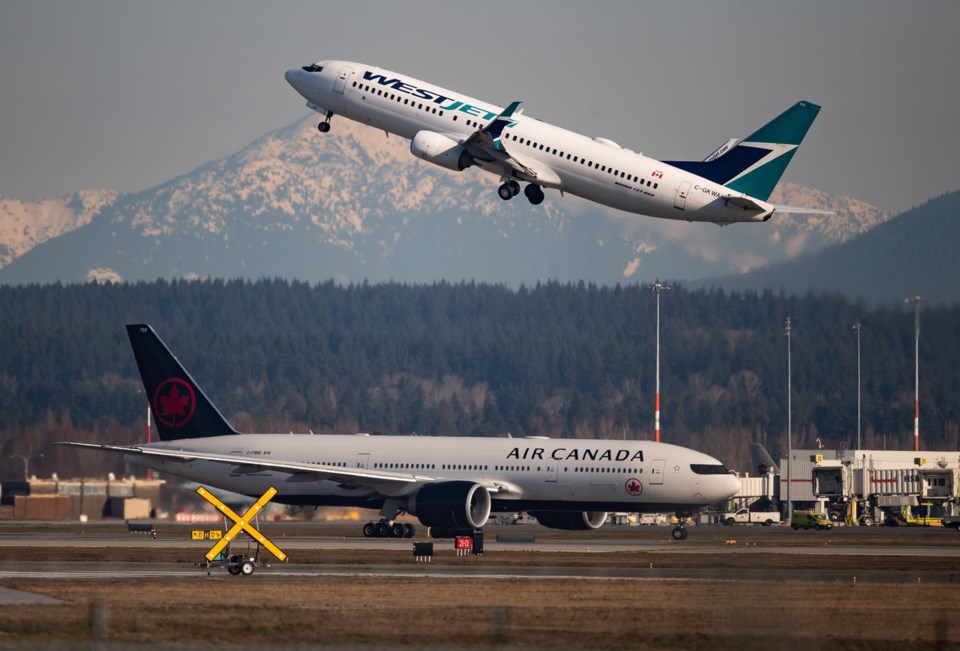Canada should allow up to 100 per cent foreign ownership of domestic-only airlines, the Competition Bureau says in a new report highlighting the country's "highly concentrated" aviation industry.
In a market study released Thursday, the watchdog suggested a new class of airline that operates only in Canada but could have owners from outside its borders, opening the gate to global expertise — and cash.
The current foreign ownership cap sits at 49 per cent. In addition, no more than 25 per cent of a carrier can be owned by any one foreign entity, a proportion the Competition Bureau proposed raising to nearly half.
"Allowing more foreign investment in Canadian airlines improves access to capital, drives growth and promotes competition," the report said, pointing to Australia and New Zealand as places that permit full outsider ownership of in-country carriers.
"As economist Michael Porter famously put it, unless a firm is forced to compete at home, it will usually lose its competitiveness abroad," Brad Callaghan, an associate deputy commissioner at the Competition Bureau, said during a press briefing.
Weak competition in the airline industry remains a big hurdle to lower prices and better service across the country, and remote communities especially, the report found.
“Competition in Canada’s airline sector has struggled to take off,” it said, noting consumers’ dissatisfaction with ticket prices and service levels.
Air Canada and WestJet together account for between half and three-quarters of all domestic passengers at major airports, according to the study.
Though competition improved between 2019 and 2023 with the arrival of Flair Airlines and the expansion of Porter Airlines, market concentration remains "extremely high" and competition from new entrants fragile, the bureau said.
“Many Canadians report that international flights are often cheaper than flights within Canada" — partly due to "cabotage" rules prohibiting point-to-point trips within Canada by foreign airlines — it noted.
The report recommended a basket of reforms that include overhauling the airport funding model so the infrastructure costs fall less on passengers, thus lowering ticket prices.
Costs on top of the fare such as airport fees, fuel taxes and security and navigation charges comprised 30 cents of every dollar that passengers paid airlines in 2023 compared with 25 cents in 2019, the study said.
Allowing secondary airports to compete with major hubs would also offer another way to expand market access for new entrants, the study said.
Currently, flight exclusivity clauses at some airports — Montreal's, for example — mean only one airport in a local area can host international flights, narrowing the range of options.
The advantages of incumbency come into play as well.
"Landing and takeoff slots at busy airports also favour airlines with existing rights due to rules on how slots are allocated," Competition Bureau deputy commissioner Anthony Durocher said.
The report stressed the unique challenges faced by remote communities and recommended a working group to ramp up service to the North, where air transportation is an “essential lifeline, even for residents who never fly” but whose food and medicine arrive by plane.
Over the past 20 months, four low-cost carriers have disappeared from the skies, as Lynx Air and Canada Jetlines shut down and WestJet folded subsidiary Swoop and the recently acquired Sunwing Airlines into its main-line service.
Canada is a noted graveyard for budget airlines. Six foundered here between 1995 and 2015: Greyhound Air, Roots Air, Air Canada's Zip, Jetsgo, Zoom Airlines and Canjet.
While the country's biggest cities remain amply served, smaller destinations have fewer options, which can also result in higher prices and, when things go awry, stranded passengers.
The Calgary-Saskatoon route saw flights fall 39 per cent to 412 last month compared with 673 in May 2019, now that the route between Alberta and Saskatchewan’s two biggest cities is served with non-stop flights by only WestJet, according to aviation data firm Cirium. Air Canada pulled out of the route over two years ago.
The report noted that routes served by just one airline tended to be more expensive.
“Our research shows that when just one new competitor flies on a route between two cities, airfares go down by nine per cent on average,” the report said.
The report also called for an end to the transport minister's power to override mergers and acquisitions deemed anticompetitive under a federal review process. And it urged industry-wide publication of data on delays and cancellations to help consumers make informed choices, on par with the United States and United Kingdom.
"The U.S. Department of Transportation publishes reams of publicly available data about the state of competition and performance in their air travel market, and Canadians would really benefit from that," said Keldon Bester, executive director of the Canadian Anti-Monopoly Project.
This report by The Canadian Press was first published June 19, 2025.
Companies in this story: (TSX:AC)
Christopher Reynolds, The Canadian Press



